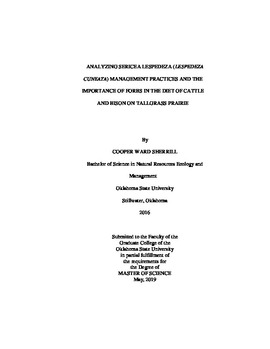| dc.contributor.advisor | Fuhlendorf, Samuel D. | |
| dc.contributor.author | Sherrill, Cooper Ward | |
| dc.date.accessioned | 2019-10-25T20:25:23Z | |
| dc.date.available | 2019-10-25T20:25:23Z | |
| dc.date.issued | 2019-05-01 | |
| dc.identifier.uri | https://hdl.handle.net/11244/321611 | |
| dc.description.abstract | Managing an invasive species while simultaneously preserving native plant diversity can be a challenge and species invasions are best understood when they are studied at multiple spatiotemporal scales. Using two large, tallgrass prairie landscapes managed to promote diversity; we assessed sericea lespedeza (Lespedeza cuneata) management practices and the effects that management had on the native plant community. At one study area, an experimental approach was taken to determine the long-term effects (19 years) of pyric herbivory on sericea lespedeza invasion and at the other study area, we performed a 21-year observational study on the effects of pyric herbivory and herbicide applications on sericea lespedeza. We also assessed the importance of forbs and an invasive legume in the diet of cattle and bison on tallgrass prairie using the trnL meta-barcoding technique. Our results indicate that the restoration of pyric herbivory with bison or cattle continues to provide the greatest invasion mitigation for sericea when compared to traditional management methods at landscape scales. Sericea invasion, as well as the management strategies put in place to control sericea, has minimal impact on the native plant community. Conservatively applied herbicide applications appeared to provide only one year of sericea control and there was no evidence for long-term benefits. Assuming that the relative read abundance (RRA) percentage for a species corresponds to the percentage of protein derived from that species; our results indicate that dicots provided 70-80% of the dietary protein throughout the growing season in both cattle and bison. Forbs in the legume family provided 60-65% of protein intake for both cattle and bison. Lespedeza sp., likely sericea, provided an average of 25-30% of bison and cattle protein intake throughout the growing season. | |
| dc.format | application/pdf | |
| dc.language | en_US | |
| dc.rights | Copyright is held by the author who has granted the Oklahoma State University Library the non-exclusive right to share this material in its institutional repository. Contact Digital Library Services at lib-dls@okstate.edu or 405-744-9161 for the permission policy on the use, reproduction or distribution of this material. | |
| dc.title | Analyzing Sericea Lespedeza (Lespedeza cuneata) Management Practices and the Importance of Forbs in the Diet of Cattle and Bison on Tallgrass Prairie | |
| dc.contributor.committeeMember | Goodman, Laura E. | |
| dc.contributor.committeeMember | Elmore, R. Dwayne | |
| osu.filename | Sherrill_okstate_0664M_16210.pdf | |
| osu.accesstype | Open Access | |
| dc.type.genre | Thesis | |
| dc.type.material | Text | |
| dc.subject.keywords | diet | |
| dc.subject.keywords | herbicide | |
| dc.subject.keywords | landscape | |
| dc.subject.keywords | observational | |
| dc.subject.keywords | prescribed fire | |
| dc.subject.keywords | trnl | |
| thesis.degree.discipline | Natural Resource Ecology and Management | |
| thesis.degree.grantor | Oklahoma State University | |
